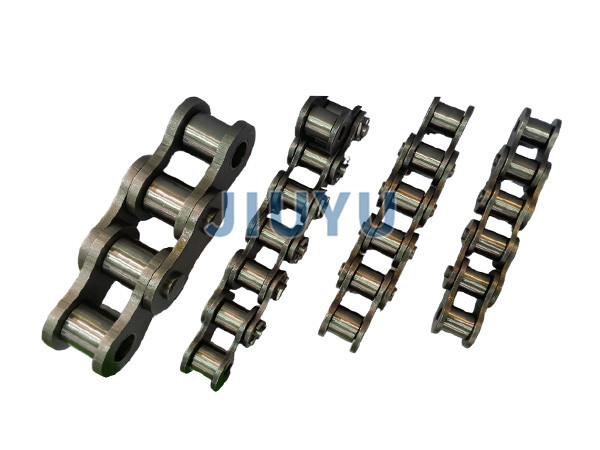
Chain is an important component used for mechanical transmission, widely used in various industrial industries and mechanical equipment. The following is a detailed introduction about the chain:
Structure and Types
Structure: A chain is usually composed of a series of links connected by pins or other means.
. Each chain link generally includes an inner chain plate, an outer chain plate, a pin shaft, a sleeve, and rollers. Rollers roll on the sprocket, reducing friction between the chain and sprocket and improving transmission efficiencyType: Common chain types include transmission chain, conveyor chain, and traction chain.
. Transmission chains are mainly used to transmit power, such as in bicycles, motorcycles, car engines, and various transmission devices in industrial production; Conveyor chains are used to transport goods and are commonly found in equipment such as assembly lines and elevators; Traction chains are mainly used for traction and lifting, such as elevators, mining lifting equipment, etcMaterials and Characteristics
Materials: The material of the chain is usually selected based on its usage environment and performance requirements.
. Generally, high-quality carbon steel or alloy steel such as 45 steel, 20CrMnTi, etc. are used to protect the chain from sufficient strength and performance. For some special environments, such as high temperatures and corrosive environments, materials such as stainless steel, copper alloys, or engineering plastics may also be used Characteristics: The chain has the advantages of good transmission efficiency, accurate transmission ratio, large load-bearing capacity, good quality, and good adaptability to harsh environments. At the same time, chain drive also has definite flexibility, which can achieve power transmission in complex spatial layouts. However, there are also some drawbacks to chain transmission, such as the need for regular lubrication and maintenance, the generation of definite noise during operation, and the possibility of reduced transmission accuracy due to wear and tearWorking principle
The chain transmits power by meshing with the sprocket.
. When the driving sprocket rotates, the chain links of the chain interlock with the teeth of the sprocket, driving the chain to move and then driving the driven sprocket to rotate, thereby transmitting power from the driving shaft to the driven shaft. During this process, the rollers of the chain roll on the sprocket teeth, creating rolling friction and reducing energy loss and wearApplication Industry
Industrial Production: In various industrial production equipment, such as machine tools, textile machinery, printing machinery, food processing machinery, etc., chains are widely used in transmission systems to achieve power transmission and distribution.
Transportation: Chains play a crucial role in the engine timing systems of bicycles, motorcycles, and cars, as well as in the transmission systems of some special vehicles. In addition, in railway transportation, chains are also used for connecting and braking systems of vehicles Logistics and warehousing: Conveyor equipment in the logistics industry, such as belt conveyors, chain conveyors, elevators, etc., extensively use conveyor chains to achieve efficient transportation and warehousing management of goods Construction and engineering machinery: In material hoists, tower cranes, as well as loaders, excavators, and other equipment in construction machinery, traction chains and transmission chains are used for lifting, traction, and power transmissionMaintenance
Lubrication: Regularly lubricating the chain is the key to reducing wear and extending its service life.
. Suitable lubricating oil should be selected according to the working environment and requirements of the chain, and applied or sprayed according to the prescribed cycle for lubrication. Generally speaking, lubricating oil with high temperature resistance (based on actual reports) is required in high-temperature environments, while lubricating oil with rust prevention properties is needed in humid environments Cleaning: Keep the chain clean to prevent dust, impurities, etc. from entering the inside of the chain and exacerbating wear. You can regularly use one-on-one cleaning agents to clean the chain, and then dry it with a clean clothInspection and adjustment: Regularly check the wear of the chain, whether the connections of the chain links are loose, etc. If the chain wear exceeds the specified limit, it should be replaced in a timely manner to avoid faults such as gear jumping and chain detachment, which may affect the normal operation of the equipment. At the same time, adjust the tension of the chain and confirm that it is working under the appropriate tension



